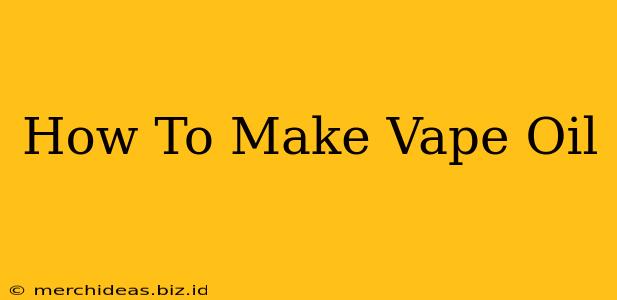Making your own vape oil can seem daunting, but with the right information and precautions, it's achievable. This guide will walk you through the process, emphasizing safety and legality. Always prioritize safety and adhere to local regulations. The information provided here is for educational purposes only and should not be interpreted as encouragement to produce or consume vape oil if it's illegal in your area.
Understanding the Basics of Vape Oil Production
Before diving in, it's crucial to understand the fundamental components and processes involved. Creating vape oil typically involves extracting cannabinoids (like CBD or THC) or other desired compounds from plant material, then diluting them in a carrier oil suitable for vaping. This carrier oil is often propylene glycol (PG) or vegetable glycerin (VG), or a blend of both. The ratio of these ingredients significantly impacts the vaping experience.
Key Ingredients and Their Roles:
- Plant Material: This is the source of your desired compounds. Common choices include cannabis (if legal in your region), hemp, or other herbs. The quality and preparation of your plant material directly influence the final product's quality.
- Carrier Oils: PG and VG are the most common carrier oils used in vape oil. PG offers a thinner consistency and a sharper throat hit, while VG produces denser vapor and a sweeter taste. Many vapers prefer a blend of both.
- Extraction Method: This is how you separate the desired compounds from the plant material. Common methods include CO2 extraction (considered the cleanest and safest), ethanol extraction, and olive oil extraction (less common for vaping).
Step-by-Step Guide to Making Vape Oil (Using CO2 Extraction - Example)
Disclaimer: This section describes a process using CO2 extraction. CO2 extraction requires specialized equipment and expertise. Improper use can be dangerous. Do not attempt this process unless you have the necessary knowledge, equipment, and safety precautions in place. This is for informational purposes only and should not be considered a comprehensive guide to CO2 extraction.
- Preparation: Start with clean, dry plant material. Properly grind it to increase the surface area for efficient extraction.
- CO2 Extraction: This involves using a CO2 extraction machine to separate the cannabinoids from the plant material. The process is controlled by adjusting temperature and pressure. This is highly technical and requires specialized equipment and training.
- Filtration and Purification: After extraction, the raw extract needs to be filtered and purified to remove unwanted impurities.
- Dilution: Carefully mix the purified extract with your chosen carrier oil (PG, VG, or a blend). The ratio depends on the desired concentration and your personal preference.
- Testing (Crucial): Before consuming, you MUST have your vape oil tested by a third-party lab to ensure purity, potency, and the absence of contaminants. This is vital for safety.
Safety Precautions
- Ventilation: Always work in a well-ventilated area.
- Protective Gear: Wear gloves, eye protection, and a respirator when handling solvents or chemicals.
- Fire Safety: Be aware of fire hazards associated with flammable solvents.
- Legal Compliance: Ensure all your actions comply with local and national laws regarding the production and consumption of vape oil.
- Proper Storage: Store your vape oil in a cool, dark, and airtight container away from direct sunlight and heat.
Alternatives to CO2 Extraction
If CO2 extraction is not feasible, consider alternative methods, although they may yield less pure products. Always research thoroughly before attempting any method. These alternatives may involve simpler processes but compromise on purity and safety.
Conclusion
Making your own vape oil requires knowledge, skill, and adherence to safety regulations. While this guide provides a general overview, it's essential to conduct thorough research and consider your safety before attempting any method. Remember, the health risks associated with vaping are significant, and using improperly made or contaminated vape oil can lead to severe health problems. Always prioritize your health and safety. This information is for educational purposes only and should not be interpreted as an endorsement of any illegal activity.
